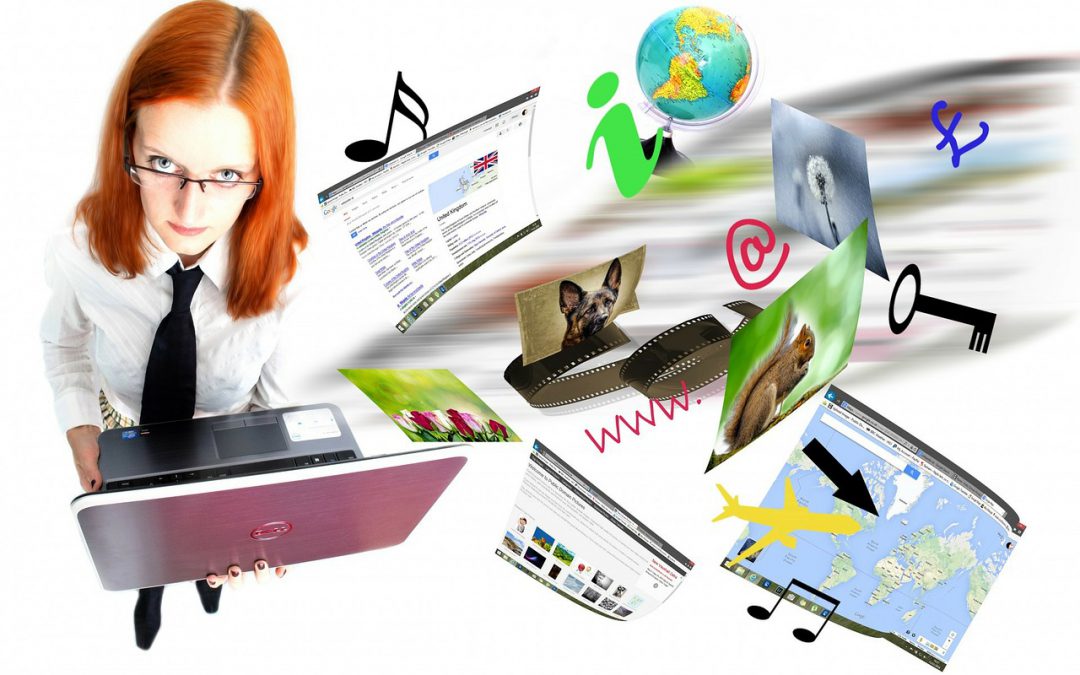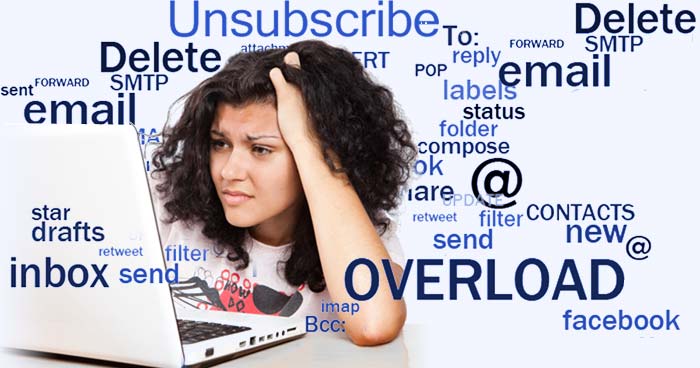By the end of 2019 it is estimated that there will be 2.9 billion email users. That is more than one third of the worldwide population. Around 246 billion emails are sent each day. Business users receive about 126 emails per day. Right there is one source for email overload.
How do we get to email overload?
Email has a kind of seduction
Having a constant stream of email certainly gives us the feeling of being busy and in demand. There’s a kind of bravado we hear when people speak about their average daily email totals. The speed and immediacy of the messages flowing into our in-box can have a slightly addictive quality as we plough through them looking for the ones that we hope will make a difference.
Soren Gordhamer in his book, Wisdom 2.0: Ancient Secrets for the Creative and Constantly Connectedwrites that one of the reasons we are so attached to our email is that we are constantly on the lookout for some good news, a lucky break in our working day. We want something to lift us up and make us feel good and we look to email as a source of possibility flowing constantly into our lives.
The Harvard Business Review recently carried an article on what it called email addiction in which it stated the findings of a survey done for the Huffington Post. Here are two of the statistics:
Out of 1200 respondents, some 60% said they spend less than two waking hours a day completely disconnected from email.
20% spend less than half an hour disconnected.
Our email has embedded itself deeply into our lives.
It creates an illusion of multitasking
It’s not just our email either. We are linked in to any number of communication tools and apps. As we sit at our computers, we are subject to alerts and notifications providing us with information that we feel is essential to keeping in touch and getting things done. We can pride ourselves on being able to switch our attention between several different demands at once but perhaps we also need to question the quality of our attention divided into so many different directions. Think about trying to answer an email on your smart phone while waiting for your train to work, or juggling your shopping in the supermarket. It may feel like using every moment fully but is it worth the risk of making an error of judgement because your attention is not focused?
Our brain is not comfortable with shifting back and forth between several different tasks. It has the effect of splitting our attention and tends to make us less productive rather than more. The quality of attention we give to each task is so reduced that it becomes counter-productive. The risk of replying to an email in this way is quite high. With our attention so divided we are likely to miss things and respond inappropriately.
It’s the same thing if we are trying to write a report while we keep an eye on our incoming email. In his book, Your Brain at Work, David Rock states that:
- on average office distractions take up about 2.1 hours per day
- employees tend to spend about 11 minutes on a task before being distracted
- people switch activities every 3 minutes
- after an interruption it takes people 25 minutes to return to their original task
Some emotional reasons for challenges with email
A lack of intimacy as a communication tool
Neuroscience has discovered that our brain’s very design makes it sociable, inexorably drawn into an intimate brain-to-brain linkup whenever we engage with another person. That neural bridge lets us impact the brain—and so the body—of everyone we interact with, just as they do us. When we communicate face-to-face we are able to form an instant connection and enhance this by how we use our voice, facial expressions and other non-verbal cues.
Add to that the increasing body of study into mirror neurons, which enable us to instinctively feel another person’s thoughts, emotions and intentions and we have a clear picture of the volume and intensity of communication that flows between people when they meet.
None of this is available to us on email. We may conduct long and important business relations with people that we rarely—or perhaps never—see.
It’s easy to misinterpret the tone of an email
When we are under pressure to answer a large number of emails we naturally try to be as succinct and efficient as possible. We cut down on the niceties and go straight for the main point. Unfortunately, for the recipient who cannot see us and maybe does not even know us well, the effect can be quite negative. Email that we intend to be concise and practical can seem to be unfeeling, or even rude.
Add to this the brain’s negativity bias, which makes it much easier for us to interpret something as hostile, even when it’s not. Designed to help us remember dangerous circumstances so we could avoid them in the future in order to survive, this feature easily converts a neutral but business-like message into an unfriendly communication. Having not given our correspondent the benefit of the doubt, we are likely to pass the irritation on in subsequent emails we send throughout the day.
Three simple steps to avoid email overload
1.Be practical
It’s easy to feel overwhelmed by the sheer volume and persistence of our email traffic but there are a number of simple things we can do that will help. It’s a question of identifying them and putting them in place as our regular habit.
Here’s a few ideas for how to be practical with your email:
- Have regular times of day for dealing with email. This will avoid the nightmare of your email spilling over your entire day and making it hard to accomplish anything else.
- Try not to answer emails on your journey to work but use the time to prepare for the day. When you are in your workplace you can give better attention to the email you are writing.
- Deal with the emails already in your inbox before you start on the incoming messages of the day. This helps you to keep track and prevents an important email slipping through the cracks.
- Sort out your inbox regularly. It is encouraging to see the volume decrease in your inbox and helps you to keep track.
- Turn off your notifications when you are working on other things. This decreases anxiety when you see emails surging into your inbox.
- Check that sending an email is the best means of communication for the message you want to send. Would a phone call work better This helps to ensure good communication.
- Check your subject line—is it identifying the topic clearly? The person receiving the email is as busy as you. Helping them assess how to deal with your message will make it more likely it is answered quickly.
- Think carefully about who you copy in—do all these people need to see your message, or will it complicate things? It helps to keep the communication channels uncluttered.
2.Be mindful
We have already looked at how often someone gets distracted from the task in hand while at work and how long it can take them to get back on track. Distraction is not just something that happens to us at work. In 2010, Harvard psychologist Daniel Gilbert and his associate, Matthew Killingsworth conducted a studyin which they developed a smart phone app to measure peoples’ happiness. During the day people were sent a series of questions asking them what they were doing and how they were feeling. The results showed that for 46.9% of their waking hours people were thinking about something other than what they were doing, and they were not feeling happy. Think about that for a moment—it is almost half of your life!
Meditation is the best way to work with distraction. Here is a very simple mindfulness meditation exercise you could try.
A simple mindfulness meditation exercise
Sit comfortably
Connect with your breathing
—stay with where the sensation is most vivid for you
—moment by moment by moment
—breath by breath by breath
—notice any changes in your breathing
Notice when your attention is not on your breathing
—check where has it gone
—dissolve the distraction
—bring your attention back to your breath
—begin again as if for the first time
Doing an exercise like this regularly will help you be less distracted with your email. Mindfulness means being present. Meditation means developing awareness. Both of these are useful skills with email.
Here’s a few ways to be mindful with your email:
- Keep in touch with yourself by maintaining awareness of your body on your chair, your chair at your desk and so on.
- Try to avoid sending email while you are on automatic pilot.
- Don’t zone out at the computer.
- Take regular short breaks to breathe deeply and relax your shoulders.
- Re-read your messages before sending them—if they are tricky emails, re-read them twice.
- When you receive a difficult email take time to separate the message from your reactions—make sure that you can get your reaction in proportion.
- Keep a photo on your desk that helps bring you back when you are distracted.
3. Be kind
We have already discussed how email does not come with an instinctive way to connect. On top of that, the brain’s negativity bias leads us to interpret business-like emails as hostile. We all know that it is all too easy to have a misunderstanding—or worse—over email. Once we are upset ourselves—or have caused upset to someone else, the ripple effect spreads and spreads as we all pass on our irritation and stress to the other people we interact with. Kindness is not something we always think of in dealing with our email and yet engaging with kindness while we deal with our inbox will help the quality of our communication—and even help to reduce our own stress levels.
Here’s a few ways to be kind with your email:
- Try to stay connected with the person you are writing to—visualize them in your mind’s eye.
- Realize that the person you are writing to is just like you—they want things to go well at work and yet they have all kinds of hassles to deal with.
- Put yourself in their shoes—how would you feel about receiving the email that you are sending?
- Don’t just dash off a quick reply in order to get it done—it can end up taking up more time.
- Never send an email when you are upset, disappointed or angry—‑chances are you are not seeing things clearly.
- If you are unsure of an email, put it in your draft box and re-read it the next morning.
- Alternatively—read a tricky email out loud to yourself to check the tone.
I would love to hear from you how you avoid email overload – do leave a comment in the box below.
If you enjoyed this post you could check out this free 5-day email course
YOUR MINDFUL SOLUTION TO EMAIL OVERLOAD


